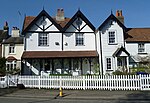Wrotham Park

Wrotham Park (pronounced , ROO-təm) is a neo-Palladian English country house in the parish of South Mimms, Hertfordshire. It lies south of the town of Potters Bar, 17 miles (27 km) from Hyde Park Corner in central London. The house was designed by Isaac Ware in 1754 for Admiral John Byng, the fourth son of Admiral George Byng, 1st Viscount Torrington, and remains in the family at the heart of a 2,500-acre (10 km2) estate. It is one of the largest private houses near London inside the M25 motorway. Its distinctive exterior has been used over 60 times as a filming location. The house is listed as a Grade II* building on the National Heritage List for England, and its landscaped park and gardens are Grade II listed on the Register of Historic Parks and Gardens.
Excerpt from the Wikipedia article Wrotham Park (License: CC BY-SA 3.0, Authors, Images).Wrotham Park
Wrotham Park, Hertsmere
Geographical coordinates (GPS) Address External links Nearby Places Show on map
Geographical coordinates (GPS)
| Latitude | Longitude |
|---|---|
| N 51.677222222222 ° | E -0.19666666666667 ° |
Address
Wrotham Park Mansion
Wrotham Park
EN5 4RY Hertsmere
England, United Kingdom
Open on Google Maps










